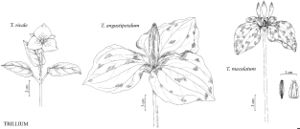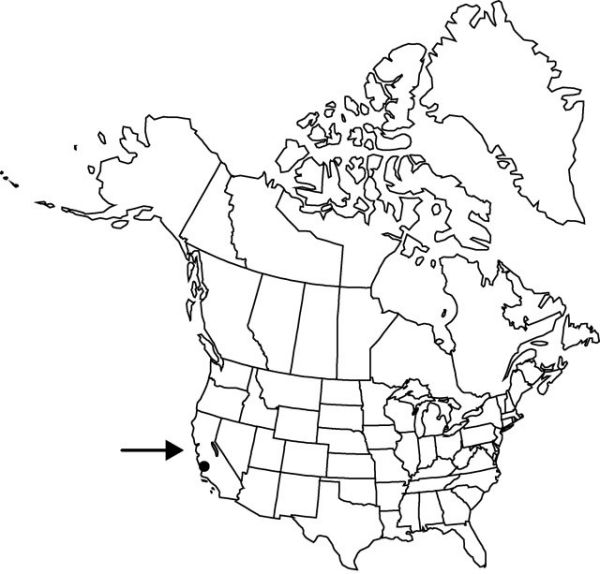Difference between revisions of "Trillium angustipetalum"
Brittonia 27: 55. 1975.
FNA>Volume Importer |
imported>Volume Importer |
||
| (6 intermediate revisions by 2 users not shown) | |||
| Line 8: | Line 8: | ||
}} | }} | ||
|common_names=Narrow-petaled trillium | |common_names=Narrow-petaled trillium | ||
| − | |basionyms={{Treatment/ID/ | + | |special_status={{Treatment/ID/Special_status |
| + | |code=F | ||
| + | |label=Illustrated | ||
| + | }}{{Treatment/ID/Special_status | ||
| + | |code=E | ||
| + | |label=Endemic | ||
| + | }} | ||
| + | |basionyms={{Treatment/ID/Basionym | ||
|name=Trillium sessile var. angustipetalum | |name=Trillium sessile var. angustipetalum | ||
|authority=Torrey | |authority=Torrey | ||
| + | |rank=variety | ||
| + | |publication_title=Pacif. Railr. Rep. | ||
| + | |publication_place=4(5): 151. 1857 | ||
}} | }} | ||
|synonyms={{Treatment/ID/Synonym | |synonyms={{Treatment/ID/Synonym | ||
|name=Trillium giganteum var. angustipetalum | |name=Trillium giganteum var. angustipetalum | ||
|authority=(Torrey) R. R. Gates | |authority=(Torrey) R. R. Gates | ||
| + | |rank=variety | ||
}} | }} | ||
|hierarchy=Liliaceae;Trillium;Trillium subg. Phyllantherum;Trillium angustipetalum | |hierarchy=Liliaceae;Trillium;Trillium subg. Phyllantherum;Trillium angustipetalum | ||
| Line 30: | Line 41: | ||
|elevation=30–200 m | |elevation=30–200 m | ||
|distribution=Calif. | |distribution=Calif. | ||
| − | |discussion=<p>Trillium angustipetalum occurs in the Sierra Nevada from Fresno County north to Placer County (J. D. Freeman 1975). It is disjunct in the coastal mountains and hills of Santa Barbara and San Luis Obispo counties.</p><!-- | + | |discussion=<p><i>Trillium angustipetalum</i> occurs in the Sierra <i>Nevada</i> from Fresno County north to Placer County (J. D. Freeman 1975). It is disjunct in the coastal mountains and hills of Santa Barbara and San Luis Obispo counties.</p><!-- |
| − | --><p>B. D. Ness (1993) listed Trillium kurabayashii as a synonym of T. angustipetalum. In bract orientation, color, and texture, and in petal shape, the two are quite different and certainly not the same species. Cytologist Masataka Kurabayashi found chromosomal differences between the two species (reported by J. D. Freeman 1975).</p> | + | --><p>B. D. Ness (1993) listed <i>Trillium kurabayashii</i> as a synonym of <i>T. angustipetalum</i>. In bract orientation, color, and texture, and in petal shape, the two are quite different and certainly not the same species. Cytologist Masataka Kurabayashi found chromosomal differences between the two species (reported by J. D. Freeman 1975).</p> |
|tables= | |tables= | ||
|references= | |references= | ||
| Line 40: | Line 51: | ||
-->{{#Taxon: | -->{{#Taxon: | ||
name=Trillium angustipetalum | name=Trillium angustipetalum | ||
| − | |||
|authority=(Torrey) J. D. Freeman | |authority=(Torrey) J. D. Freeman | ||
|rank=species | |rank=species | ||
| Line 54: | Line 64: | ||
|publication title=Brittonia | |publication title=Brittonia | ||
|publication year=1975 | |publication year=1975 | ||
| − | |special status= | + | |special status=Illustrated;Endemic |
| − | |source xml=https:// | + | |source xml=https://bitbucket.org/aafc-mbb/fna-data-curation/src/2e0870ddd59836b60bcf96646a41e87ea5a5943a/coarse_grained_fna_xml/V26/V26_120.xml |
|genus=Trillium | |genus=Trillium | ||
|subgenus=Trillium subg. Phyllantherum | |subgenus=Trillium subg. Phyllantherum | ||
Latest revision as of 21:12, 5 November 2020
Plants tall, very robust. Rhizomes erect, brownish, thick, somewhat compressed-thickened, praemorse, not brittle. Scapes 1–2, round in cross section, 2.5–6 dm. Bracts held well above ground, spreading horizontally, subsessile; blade very sparsely mottled with dark greenish brown or rarely all green, mottling becoming obscure with age, broadly ovate, 10–22 × 8.7–15 cm, not glossy, often narrowed to falsely petiolate, very short, and narrowly cuneate base 10–20 mm, apex obtuse. Flower erect, odor spicy-musty, musty, or fetid; sepals conspicuous, spreading, often resting on bracts, maroon to green, linear to oblong-lanceolate, 35–47 × 8–10 mm, margins flat, entire, apex acute; petals long-lasting, erect, ± connivent, ± concealing stamens and ovary and partially obscuring stamens, dark purple to red-purple, not spirally twisted, veins obscure, linear, 5–10 × 0.7–1.4 cm, 8–10 times longer than wide, glossy, thick-textured, base linear, margins entire, at first flat but inrolling with age, apex variously acute-obtuse; stamens erect, 12–22 mm; filaments dark maroon, 2–4 mm, slender, widest at base; anthers erect, straight, purple, 12–18 mm, dehiscence introrse; connectives purple, slightly extended 1–1.5 mm beyond anther sacs; ovary dark, ovoid-ellipsoid, 6-angled toward apex, 7.5–12 mm; stigmas erect, divergent-recurved, distinct, purple, sessile, awl-shaped, thickly subulate, 5 mm, thick, fleshy. Fruits dark purple, fragrance unknown, subglobose, 6-angled, almost winged, fleshy. 2n = 10.
Phenology: Flowering spring–early summer (Mar–Jun).
Habitat: Big-tree (Sequoiadendron) groves and other mixed coniferous-deciduous flatwoods, slightly damper depressions under maples and deciduous shrubs, coastal mountains, oak (Quercus) groves in ravines and otherwise quite arid, almost treeless chaparral, wooded canyon slopes, dense woods near streams
Elevation: 30–200 m
Discussion
Trillium angustipetalum occurs in the Sierra Nevada from Fresno County north to Placer County (J. D. Freeman 1975). It is disjunct in the coastal mountains and hills of Santa Barbara and San Luis Obispo counties.
B. D. Ness (1993) listed Trillium kurabayashii as a synonym of T. angustipetalum. In bract orientation, color, and texture, and in petal shape, the two are quite different and certainly not the same species. Cytologist Masataka Kurabayashi found chromosomal differences between the two species (reported by J. D. Freeman 1975).
Selected References
None.

